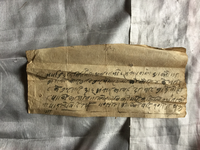A receipt for an amount received for fraudulently traded salt sold in auction (1950 VS)
ID: Tsum_0001_0023
Edited and
translated by Nadine Plachta and Rajendra Shakya
Created: 2018-02-19;
Last modified: 2020-07-24
For the metadata of the document, click here
The accompanying edition, translation/synopsis and/or commentary are available under the terms of the Creative Commons Attribution-ShareAlike 4.0 International License
Abstract
This is a receipt from Sirdibas Amānata Revenue [and] Customs Office for an amount received from the auction of fraudulently traded salt.Diplomatic edition
[1r]
1श्री:[Unknown seal]1भर्पाईदादैसिर्तिवासअमानतपोटभंसारकस्ये९//क्यौमा2अंगालेचोरिढाटिनुन्वेपारगर्योकोचौरि४केभारि
3८केनुन्मुरि३|६भंन्सारकावहीदारवाटवुझिमोहो
4रपाथिकाभाव़मालिलाम्विक्रीगरिबुझिलिञ्युंतस्को
5भरपाइलेषिदिञ्यूं५०सालआश्विनवदि१०रोज५शु
6भ्म्¯¯¯ ¯¯¯ ¯¯¯ ¯¯¯ ¯¯¯ ¯¯¯ ¯¯¯ ¯¯¯
Translation
[1r]
[Unknown seal]
Receipt (bharpāīdādai): From the Sirdibas1 Amānata Revenue [and] Customs Office
After receiving from the bahīdāra of the customs office 3 murīs 6 pāthīs of salt [that was smuggled into the village] in 8 packs [lit. loads] on 4 yaks and was being traded by … 2 , [we] sold it at auction for mohara [per] pāthī [bids] and received 9 moharas 2 ānās (?). We issued a receipt for the same.
Thursday, the 10th of the dark fortnight of Āśvina of the [Vikrama Era] year [19]50 (1893 CE). Auspiciousness.
Commentary
The Sirdibas Amānata Revenue [and] Customs Office obviously served a twofold function: both as a land revenue office and as a customs office. The reason for the confiscation of salt mentioned in the document is unclear. The locally traded salt was probably smuggled into Nepal from Tibet. After the confiscated salt was deposited in the office treasury, it was auctioned off for cash. However, the amount received is not clear either. What appears to be “9 rupees 2 ānās” at the beginning of the document may have been some amount received from the auction. Although auctions provide opportunities to buy things very cheaply, that amount is exceedingly low for the 66 pāthīs of salt that was auctioned off. An instruction from Prime Minister Raṇa Uddīpa Siṃha in VS 1942 reveals that the price of salt in Olāṅcuṅga Golā, a village in the far- eastern part of the country, was 1 pāthī 4 mānās a rupee (Regmi 1989: 26). Another possibility is that salt was much cheaper there than in Olāṅcuṅga Golā because it was easier to come by and closer at hand.

